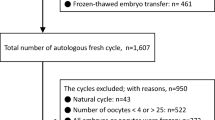Summary
This study aimed to investigate the effect of different gonadotropin-releasing hormone agonist (GnRH-a) administration methods on pregnancy outcomes of patients undergoing in-vitro fertilization-embryo transfer (IVF-ET). Clinical data of 5217 patients who underwent IVF-ET were retrospectively analyzed. Patients were divided into the long-acting GnRH-a group (n=1330) and the short-acting GnRH-a group (n=3887) based on their various treatment plans. The clinical and laboratory embryo data and clinical pregnancy outcomes were compared between the two groups. The results showed that there were no significant differences in the age, infertility, primary/secondary infertility rate, IVF rate, body mass index (BMI), antral follicle counting (AFC), follicle-stimulating hormone (FSH) level, and the number of transplanted embryos between the two groups (P>0.05). There were no significant differences in the oocyte numbers, MII rate, fertilization rate, cleavage rate and blastocyst formation rate (P>0.05) between the two groups. The gonadotropin (Gn) using days, Gn dose and endometrial thickness were significantly greater in the long-acting GnRH-a group than those in the short-acting GnRH-a group (P<0.01). Additionally, the estradiol (E2) levels, blastocyst freezing rate, embryo utilization rate, transplant cancellation rate and abortion rate were significantly lower in the long-acting GnRH-a group than those in the short-acting GnRH-a group (P<0.01). The clinical pregnancy rate and embryo implantation rate were significantly higher in the long-acting GnRH-a group than in the short-acting GnRH-a group (P<0.01). It was concluded that use of long-acting GnRH-a can effectively reduce the transplant cancellation rate and improve the clinical pregnancy rate of the fresh cycle.
Similar content being viewed by others
References
Guo N, Hua X, Li YF, et al. Role of ICSI in Nonmale Factor Cycles as the Number of Oocytes Retrieved Decreases from Four to One. Curr Med Sci, 2018, 38(1):131–136
Warner B, Worgul TJ, Drago J, et al. Effect of very high dose D-leucine6-gonadotropin-releasing hormone proethylamide on the hypothalamic-pituitary testicular axis in patients with prostatic cancer. J Clin Invest, 1983, 71(6):1842–1853
Hupe MC, Hammerer P, Ketz M, et al. Retrospective Analysis of Patients With Prostate Cancer Initiating GnRH Agonists/Antagonists Therapy Using a German Claims Database: Epidemiological and Patient Outcomes. Front Oncol, 2018,8:543
Oliveira JB, Baruffi R, Petersen CG, et al. Administration of single-dose GnRH agonist in the luteal phase in ICSI cycles: a meta-analysis. Reprod Biol Endocrinol, 2010,8:107
Al-Inany HG, Youssef MA, Ayeleke RO, et al. Gonadotrophin-releasing hormone antagonists for assisted reproductive technology. Cochrane Database Syst Rev, 2016,4:CD001750
Ren J, Sha A, Han D, et al. Does prolonged pituitary down-regulation with gonadotropin-releasing long- and short-acting GnRH-a hormone agonist improve the live-birth rate in in vitro fertilization treatment? Fertil Steril, 2014,102:75–81
Devreker F, Govaerts I, Bertrand E, et al. The long-acting gonadotropin-releasing hormone analogues impaired the implantation rate. Fertil Steril, 1996, 65(1):122–126
Albuquerque LE, Tso LO, Saconato H, et al. Depot versus daily administration of gonadotrophin-releasing hormone agonistprotocols for pituitary down regulation in assisted reproduction cycles. Cochrane Database Syst Rev, 2013,(1):CD002808
Wang R, Wang F, Yang L, et al. Effects of long-acting GnRH: a prolonged protocol in assisted pregnancy via IVF-ET in infertile patients with PCOS. Minerva Chir, 2018, 73(2):251–253
Surrey ES, Silverberg KM, Surrey MW, et al. Effect of prolonged gonadotropin-releasing hormone agonist therapy on the outcome of in vitro fertilization-embryo transfer in patients with endometriosis. Fertil Steril, 2002,78:699–704
Zhang HJ, Song XR, Lü R. Modified super-long down-regulation protocol improves fertilization and pregnancy in patients with poor ovarian responses. Chin Med J (Engl), 2012, 125(16):2837–2840
Guo YH, Lu N, Zhang Y, et al. Comparative study on the pregnancy outcomes of in vitro fertilization-embryo transfer between long-acting gonadotropin-releasing hormone agonist combined with transvaginal ultrasound-guided cyst aspiration and long-acting gonadotropin-releasing hormone agonist alone. Contemp Clin Trials, 2012, 33(6):1206–1210
Duan L, Bao S, Li K, et al. Comparing the long-acting and short-acting forms of gonadotropin-releasing hormone agonists in the long protocol of IVF/ICSI Cycles: A retrospective study. J Obstet Gynaecol Res, 2017, 43(6):1037–1042
Gao J, Xu YW, Miao BY. Self-control study on reduced-dose depot versus daily administration of gonadotrophin-releasing hormone agonists for pituitary desensitization in in vitro fertilization cycles. J Obstet Gynaecol Res, 2014, 40(7):1901–1906
Younes G, Tulandi T. Effects of adenomyosis on in vitro fertilization treatment outcomes: a meta-analysis. Fertil Steril, 2017, 108(3):483–490
Long QQ, Zhang SF, Han Y, et al. Clinical efficacy and safety of gonadotropin releasing hormone agonist combined with estrogen-dydrogesteronea in treatment of endometriosis. Zhonghua Fu Chan Ke Za Zhi (Chinese). 2010,45(4):247–251
Author information
Authors and Affiliations
Corresponding author
Additional information
This work was supported by the Natural Science Foundation of Hubei Province (No. 2017CFB262).
Rights and permissions
About this article
Cite this article
Wu, L., Ren, Xl., Chen, W. et al. Influence of Different Gonadotropin-releasing Hormone Agonist Administration Methods on Pregnancy Outcomes of Patients Undergoing In-vitro Fertilization-embryo Transfer. CURR MED SCI 39, 437–441 (2019). https://doi.org/10.1007/s11596-019-2056-9
Received:
Revised:
Published:
Issue Date:
DOI: https://doi.org/10.1007/s11596-019-2056-9



